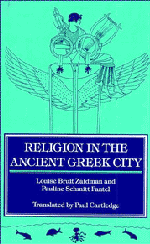Book contents
- Frontmatter
- Contents
- List of illustrations
- Author's preface to the English translation
- Translator's introduction
- List of sources
- PART I Introduction: How should we study Greek civic religion?
- PART II Cult-practices
- PART III Systems for representing the divine
- 12 Myths and mythology
- 13 A polytheistic religion
- 14 Forms of imaginative projection
- PART IV Envoi
- Appendixes
- Bibliography
- Index
14 - Forms of imaginative projection
Published online by Cambridge University Press: 05 June 2012
- Frontmatter
- Contents
- List of illustrations
- Author's preface to the English translation
- Translator's introduction
- List of sources
- PART I Introduction: How should we study Greek civic religion?
- PART II Cult-practices
- PART III Systems for representing the divine
- 12 Myths and mythology
- 13 A polytheistic religion
- 14 Forms of imaginative projection
- PART IV Envoi
- Appendixes
- Bibliography
- Index
Summary
DIFFERENT WAYS OF REPRESENTING THE DIVINE
The Greeks did not recognize one and only one mode of representing the divine, the familiar anthropomorphic statue. Different forms of representation coexisted peacefully in any given epoch. In this chapter we attempt to answer two questions: what were these different forms? And what can they teach us about Greek conceptions of the divine?
First, though, some remarks of a general nature are in order. The special characteristic of all religious representation is to endow the divinity being figured with a presence without obscuring the fact that it is not actually there. The cultic image must at the same time be thoroughly material – it can be touched, moved, manipulated – and yet leave no doubt that it stands for something which is not actually present. In the ancient Greek world, however, images were not conceived in the same terms as they are today. Notions of likeness and imitation of an external model, which are basic to our definition of an image, were not fundamental for the Greeks. At least until the beginning of the fifth century bce, none of the plastic forms in which the divine was expressed could be subsumed into the category of either likeness or imitation. These Archaic Greek representations gave form to that which had none, but they were not mimetic.
The Greeks employed a large number of different words for representations of the divine: xoanon, bretas, andrias, palladion, agalma, kolossos, eikōn and eidōlon, among others.
- Type
- Chapter
- Information
- Religion in the Ancient Greek City , pp. 215 - 228Publisher: Cambridge University PressPrint publication year: 1992

